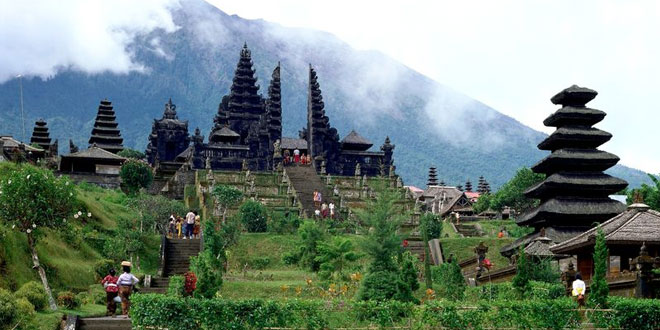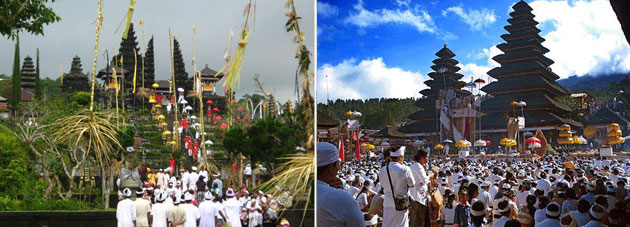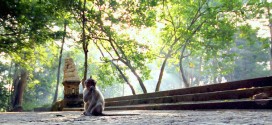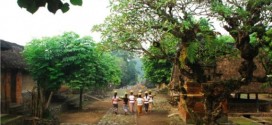
Pura Besakih is most fascinating at festival times, but it is grand and impressive whenever you go there. The drive up the mountain to Besakih, with a stopover in Klungkung for sight-seeing and shopping, takes a full day. To resume the tour of East Bali, if you are staying in Denpasar, it is best to leave early in the morning the following day. By passing through Klungkung before noon, you may choose a site to lunch on the beach or in the shaded countryside and visit the Bat Cave, tshing villages and Tenganan before reaching Karangasem in mid-afternoon. Now that the new road linking Rendang and Karangasem has been finished, it is possible to make a Besakih- Karangaserm round trip comfortably in a day. You may be lucky to arrive in Bali during a time when eastern villages are holding ceremonies. Festivals, unique to these villages, should not be missed, so check the calendar of events at your hotel to find a good time to visit.
Besakih Temple is the biggest Hindu temple in Bali which the local people call Pura Besakih. It owns beautiful view from the top of temple area where we can see the wide nature panorama until to the ocean so that way this temple is many visited by tourists from all over the world. Besakih Temple is located in Besakih countryside, Rendang sub district, Karangasem regency, east part of the island. It is located in southwest side bevel of mount Agung, the biggest mounts in Bali. It is because pursuant to Agung Mount confidence is holiest and highest mount in Bali Island.

Within the Besakih complex, the paramount sanctuary is the Pura Panataran Agung which rears its lofty merus on a high bank of terraces, Steps ascend in a long perspective to the austere split gate. Inside the main courtyard stands the three-seated shrine enthroning the Trisakti, the trinity of Brahma, Visnu and Siwa, During festivals the shrines are wrapped in colored cloth symbolic of the deities. The Pura Panataran Agung and two other important temples higher up the slope likewise together symbolize the Trisakti. In the center Pura Panataran Agung is hung with white banners for Siwa; to the right, Pura Kiduling Kreteg vyith red banners for Brahma; and Pura Batu Mddeg, to the left, with black banners for Visnu. These latter two temples are taken care of by . the Karangasem and Bangli regencies respectively, certain other shrines being the responsibility of the other regencies. All of Bali comes together at Pura Besakih. Religiously, oneness is symbolized in thepadmasana in Pura Panataran Agung, dedicated to Sang Hyang Widdhi, the Supreme God.
The Besakih’s name is come from the word of Basuki, the old language from Sanskrit Wasuki, and then it become the Ancient Java Language. In this Sanskrit, the Basuki means congratulation. In mythology of Samudramanthana has mentioned that Basuki is a dragon that twines the Mount Mandara. The omission has come from tradition megalithic which had been indicated that it had to be sanctified place. It seems, the Besakih is coming from very old era which is far before the existence of Hinduism influence. Hereinafter, an Ancient Bali king of Sri Kesari Warmadewa found the Merajan Selonding Temple in this temple complex area. He also commands to build the Blanjong Monument that is located in Sanur Village. The Besakih Temple complex is built pursuant to cosmos balance. It is based on the nature conception which is disseminating the fundamental temple complex that is arranged to pursuant of the way direction. So, this building can deputize nature as symbolic of the world balance existence.
Besakih Temple is located in the plateau area which is covered by the cool atmosphere and Mount Agung as a back drop. From the top of temple building, we can see the beautiful panorama of nature from the temple area to the ocean. It is situated in cool area with the light breeze and unique temple buildings spread out in the temple complex will create the peaceful atmosphere. It is ideally for the people who did the meditation and now, the Besakih Temple is opened for tourist and it is the great place to visit in Bali.




